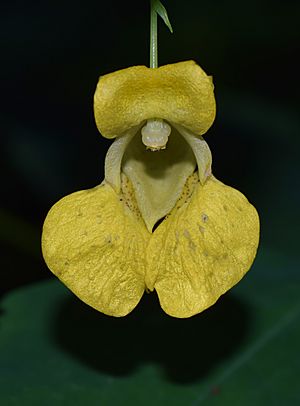Balsaminaceae facts for kids
Quick facts for kids Balsaminaceae |
|
|---|---|
 |
|
| Impatiens pallida flower | |
| Scientific classification |
The Balsaminaceae is a fascinating family of flowering plants. It includes about 850 to 1,000 different kinds of plants. Most of these plants belong to the genus Impatiens. The two main groups, or genera, in this family are Impatiens and Hydrocera.
These plants are known for their unique flowers and interesting ways of spreading seeds. Many of them are popular garden plants around the world.
Contents
What Are Balsaminaceae Plants?
The Balsaminaceae family is made up of plants that mostly grow in wet, shady places. They can be found in many parts of the world. Most species are herbs, which means they have soft stems instead of woody ones. Some are annuals, living for only one growing season. Others are perennials, meaning they live for many years.
Where Do They Grow?
Balsaminaceae plants are found in tropical and subtropical regions. This means they like warm climates. You can find them in Africa, Asia, and Europe. They often grow near streams, in forests, or in other damp areas. Some types, like certain Impatiens species, can also be found in cooler, temperate zones.
What Do They Look Like?
Plants in the Balsaminaceae family have distinct features. Their leaves are usually simple, meaning they are not divided into smaller leaflets. They often have jagged or toothed edges. The stems are often juicy and somewhat transparent.
Flowers of Balsaminaceae
The flowers are a key feature of these plants. They are often brightly colored, like pink, purple, red, orange, or white. Many have a special shape with a spur at the back. This spur is a tube-like part that holds nectar, attracting pollinators like bees and hummingbirds.
Seed Pods and Dispersal
One of the most exciting things about Balsaminaceae plants is how they spread their seeds. Many species, especially Impatiens, have seed pods that burst open when touched. This is why some are called "touch-me-not" plants. When the ripe pod is gently squeezed, it suddenly coils up and shoots its seeds far away. This helps the plant spread its offspring to new places.
Main Genera in Balsaminaceae
The Balsaminaceae family has two main groups of plants. These are Impatiens and Hydrocera. Each group has its own special characteristics.
Impatiens: The Touch-Me-Nots
The genus Impatiens is by far the largest in the family. It includes hundreds of different species. Many Impatiens are popular garden flowers. They are loved for their colorful blooms and ability to grow in shady spots.
- Garden Balsam (Impatiens balsamina): This is a classic garden plant. It has beautiful flowers that grow along its stem.
- Busy Lizzie (Impatiens walleriana): This is one of the most common Impatiens grown in gardens and hanging baskets. It produces many small, bright flowers.
- Himalayan Balsam (Impatiens glandulifera): This tall plant has large, pinkish-purple flowers. It is known for its explosive seed pods.
Hydrocera: The Water Balsam
The genus Hydrocera has only one known species, Hydrocera triflora. This plant is quite different from most Impatiens. It is an aquatic plant, meaning it grows in water.
- Water Balsam (Hydrocera triflora): This plant grows in swamps and shallow waters in Southeast Asia. It has floating stems and small, colorful flowers. Its fruit is a berry, not an explosive capsule like Impatiens.
Why Are Balsaminaceae Important?
Balsaminaceae plants are important for several reasons. They add beauty to gardens and natural landscapes. Many species are used as ornamental plants around the world.
- Gardening: Impatiens are very popular for adding color to shady areas. They are easy to grow and come in many varieties.
- Ecology: These plants provide nectar for pollinators like bees, butterflies, and hummingbirds. They are part of the food web in their natural habitats.
- Traditional Uses: In some cultures, certain Balsaminaceae species have been used in traditional medicine.
Images for kids
See also

- In Spanish: Balsaminaceae para niños


